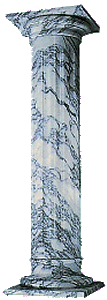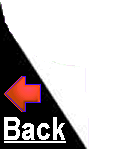
One Thing is Clear. Hebrew is a Lot Easier than English
|

When thinking about these changes, the time element must be
considered. It was not that long ago that America celebrated its 200th
birthday - two centuries. To keep these transitions in perspective we
must remember most of these changes took two or three times that span of years.
Certainly, the first immense influence to our languages and writing was
the initial 'sound ' alphabet created by the Phoenicians.
The next huge influence was Greek.
About 400 years (or two USA's) before Jesus - as previously mentioned - our
Greek friends reversed the basic sound alphabet to read
from left to right and caused many of the letter symbols to
be mirrored. The fact that today you read from left to right, while both
those who speak Arabic as well as the Hebrew Jews and the original Bible
read from right to left, is entirely their fault.
Thus, after the Greeks settled on left to right
the second letter reversed
to:  . .
Then hundreds of years later it looked like
this:  . .
At the pinnacle of Greek worldly influence it finally evolved into
this:  . .
Within the history of A and B,
1 and 2,
all these items are strongly related to one another:


food
alpha~
A
1
aleph~

|

|


shelter
~bet
B
2
~beyt

|
Before we move on to the fascinating words of the original Hebrew Old Testament,
it should also be pointed out our alphabet isn't the only thing we have
in common with Hebrew.
Many of our common everyday English words had their
roots in these ancient terms. For example, consider the Hebrew word
 spelled
yud-
shin (Rule #1: right to left). Properly pronounced "yesh",
this word translates to a positive indication (a concept similar to
"there is" or "it is necessary" affirmative) - the
predecessor roots of our own affirmative, "yes ".
spelled
yud-
shin (Rule #1: right to left). Properly pronounced "yesh",
this word translates to a positive indication (a concept similar to
"there is" or "it is necessary" affirmative) - the
predecessor roots of our own affirmative, "yes ".
You've now seen some of the primitive roots of our letters and words.
You have also seen the strange gyrations they went through to eventually
arrive at what we use today. But this project isn't about our
 English alphabet. It's about the original Bible - and
it's about Hebrew. Some of you may not have been extremely
English alphabet. It's about the original Bible - and
it's about Hebrew. Some of you may not have been extremely
 excited about the idea our 'A' and 'B' (as well as our '1' and '2')
originally came from the symbol-words for 'food' and 'shelter' - but the storyline behind
the twenty other Hebrew alephbeyt characters is just as fascinating, especially one of
them. If the oxen-A and the house-B didn't get your attention,
then also consider this ;
excited about the idea our 'A' and 'B' (as well as our '1' and '2')
originally came from the symbol-words for 'food' and 'shelter' - but the storyline behind
the twenty other Hebrew alephbeyt characters is just as fascinating, especially one of
them. If the oxen-A and the house-B didn't get your attention,
then also consider this ;
The ancient characters shown above were used when writing was brand
new. Thousands of years before the birth of Jesus
there existed another Hebrew symbol called a Taw. This
symbol was to eventually evolve into the modern Hebrew letter Tav, which
is the final or closing letter of the alephbeyt.
What is far more intriguing however, is the original meaning of this particular
word-symbol.
The Taw symbol represented simply two crossed sticks.
But five thousand years
ago this symbol meant a monument, a signal, or
remembrance.
3,000 years before Jesus,
that shrine symbol looked exactly like this:

Now that you've seen the many twists and turns each character took to arrive at both the
modern Hebrew letters as well as our own English alphabet, some of you may be
curious about the entire collection. Fascinating roots aren't limited to the
first two letters or the amazing Taw. Another example, the concept
of our 'M' beginning with a simple drawing of water waves could be
discussed in length - but to save a little time we present instead the following
complete table for you to study and enjoy.
Several other interesting things may catch your eye,
such as the symbol for 'Hey !' - "Look at me!". If you've ever referred to legs
as "gams", the origin of that is here. Especially bewildering is the symbol for
a 'son' or 'heir':
 once a picture-word for 'seed' - an interesting symbol which existed thousands
of years before microscopes looked at the male sperm.
once a picture-word for 'seed' - an interesting symbol which existed thousands
of years before microscopes looked at the male sperm.
It is the recognition of each character having a root meaning that gives
us the Root Character Method and our dictionary of these words.
On the page which follows we'll get back to
those original words.


the Journey Continues ...
|
|